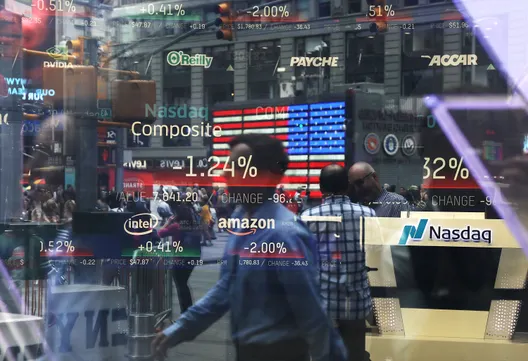Coming into the year, deal experts were optimistic that, after months without a flashy buyout, the pharmaceutical industry was ready to do more and larger transactions. Legal and financial teams were pulled into many “substantive meetings” for “real deals to get done,” according to Andrew Merken, shareholder at the law firm Polsinelli. And their hopes were seemingly affirmed when, in mid-January, Johnson & Johnson agreed to purchase a brain drug developer for nearly $15 billion.
But the excitement didn’t last. President Trump’s return to office, once seen as a positive for biotechnology deals, has instead brought dramatic stock market swings that make mergers and acquisitions harder to close, especially those worth north of a few billion dollars.
“There’s always uncertainty,” Merken said. “This is uncertainty on steroids.”
In this turbulent environment, biotech buyers are treading cautiously. They’re more afraid to misstep than to miss out, and as a result have adopted a wait-and-see approach to bigger-ticket deals. “Acquirer confidence is certainly not at its high point right now,” said Tom Davidson, global co-head of investment banking at Leerink Partners.
Sellers, meanwhile, hold less negotiating power than several years ago, so face pressure to lower their expectations on price — a proposition some management teams are having trouble swallowing.
“There’s absolutely been a shift in terms of overall mindsets in relation to M&A,” said Michael Kingston, managing director and co-head of biopharma at the financial advisory firm Lazard.
Biotech stocks have swung with broader market
Advisers see that shift manifest in different ways. At one of the most prominent life sciences law firms, Goodwin Procter, global head of M&A Stuart Cable is finding deals that previously would have wrapped in a few weeks now take three to four months to complete. He pointed to four billion-dollar-plus transactions his team had been working on since January that still weren’t finalized by mid-April.
“I can’t tell you with any certainty which, if any, will actually sign and get announced,” he said. “That is the opposite of my experience. And I do as many of these as anyone in the world.”
Cable describes the buyer pool as uncharacteristically indecisive. They’re running multiple deal processes at the same time, he said, doing what feels to him like an interminable amount of due diligence, and “occasionally killing deals in the end for no good reason.” Others chalk this up to buyers learning from mistakes they made during a boom period a few years ago, when deals were occurring more regularly.
Usually, fear that a rival might swoop in and nab an asset would spur acquisitions to close. Four companies expressed interest in cancer drugmaker RayzeBio, for instance, before it ultimately sold to Bristol Myers Squibb for $4.1 billion in late 2023. But that kind of competition — and urgency — has been missing this year as buyers hug the sidelines.
“When there’s a fear of loss, when you think the deal may go away from you and your CEO really wants it, then people move quickly,” Cable said. “In the absence of that competitive tension, why should anybody move fast?”
One of the biggest obstacles to completing deals in the current market is parties being unable to agree on price. Stock fluctuations like those seen throughout April, as the Trump administration see-sawed on tariffs, can intensify fears that a buyer might overpay or a seller may leave money on the table.
Share price swings also affect deal premiums, which can be a major sticking point in deal talks. Premiums typically ratchet up as deal talks progress, but if a target company’s stock slips significantly during negotiations, it can turn an initially healthy premium into an extravagant one. Buyers may therefore be disinclined to offer more.
“At the end of the day, we’ve got to get to a ‘yes’ on price,” Cable said, “and when the stock prices are going up and down by 5% or 10% weekly or even daily … it’s damned hard.”
Further complicating deal talks is a recent change in power dynamics. Just a few years ago, smaller drug developers could easily get the cash they needed to operate either from venture capitalists or the public markets, which then forced large pharmaceutical firms pining for a deal to increase their bids. In 2022, more than half a dozen biotechs sold for triple-digit premiums.
Premiums trend lower amid fewer public biotech acquisitions
But a prolonged downturn in the biotech stock market has since made raising money far more difficult and dilutive. Big pharmas sense this anxiety and are trying to take advantage. With their strong balance sheets, they can offer less and wait until sellers get desperate enough to accept.
That’s been a tough adjustment for biotechs, which may explain why more acquisitions have yet to be inked. “We’ve seen deals fall apart, term sheets not get signed because they’re so far apart on valuation,” Merken, of Polsinelli, said.
Big pharma executives acknowledged as much during the latest earnings season. “We continue to see, at least in the conversations we’ve had, a little bit of a disconnect between what is the reality of the market that the sellers face and what is the expectation for value that they have,” Merck & Co. CEO Rob Davis told investors in late April.
This disconnect has left industry watchers to guess when, exactly, M&A activity will rebound. Merken expects that, until the impact of tariffs on pharmaceuticals becomes clearer, the pace will stay slow, so “nothing great is going to happen” at least for the next couple months. He’s not the only one.
“If I was a pharma company and I had the prospect of tariffs and all this stuff going on, am I going to say, ‘Yeah, I need to buy this today,’ or am I going to wait for some of this to settle?” said Evan Seigerman, a managing director and senior research analyst at BMO Capital Markets. “Because if I do it now or three months from now, nothing’s really going to change.”
Buyers, he added, are “weighing whether or not they’re going to get smoked if they announce a deal.”
Advisers note how that anxiety — to only do deals which please investors or are broadly perceived as smart — is felt not only by the companies, but by individual members of their business development teams. And it can have a real effect on whether a transaction goes through, especially in a market where investments can quickly lose value.
“If I’m the head of [business development] for a company,” Merken said, “I would rather kill a deal or not enter into a deal than take significant risk that is going to make me look really bad and potentially impact my career.”
Despite these many headwinds, advisers say dealmaking activity behind the scenes remains healthy. Big pharmas still rely on the biotech sector to fill their pipelines with new medicines and technologies. And with capital markets still soured on the life sciences, those smaller developers, especially the private ones, may be forced to enter partnerships or out-license experimental medicines, if not pursue a full-scale sale.
“There’s still lots of activity happening underneath the surface,” according to Lazard’s Kingston.
Research collaborations, in particular, have become more popular given that they’re viewed as a lower-risk way for buyers to access innovation. The Goodwin team that specializes in these types of deals is “busier than ever,” Cable said.
On the M&A side, buyers want to double down in their core areas of research. They’re on the hunt for “derisked” assets — which often means drugs backed by human data that shows they work as intended. Yet the slate of well-priced, derisked products with large commercial opportunities is “pretty narrow,” Kingston said.
Experts believe that, in the near-term, deals ranging from about $1 billion to $5 billion will be most attractive. That prediction gained some support last week, when Merck KGaA agreed to buy the cancer biotech SpringWorks Therapeutics for just shy of $4 billion. The offer represents a 26% premium to SpringWork’s average share price over the course of the month prior to reports a deal was brewing between the two companies.
As for more expensive transactions, Leerink’s Davidson argues anything above $10 billion would be challenging, though still possible. He also anticipates that, in the coming months, dealmakers will get acclimated to greater levels of uncertainty.
If they don’t, biotech companies may be in for stormier times. Investors often base their bets on whether they believe a big pharma buyout down the road is possible. Remove that takeout “thesis” and investing in biotech could become an even riskier proposition than it is now.









